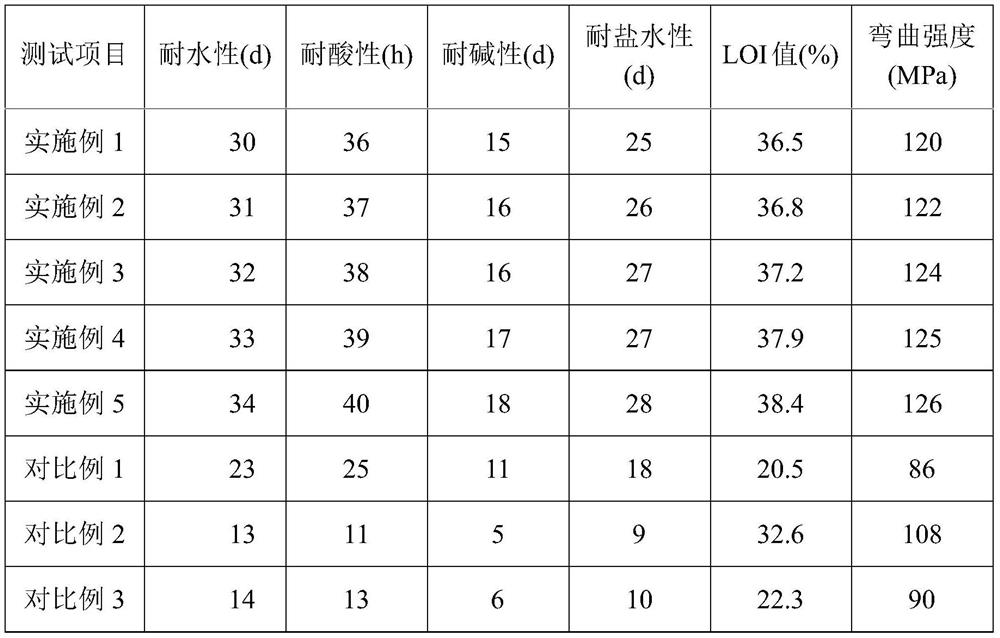Water-resistant flame-retardant epoxy resin curing agent and preparation method thereof
An epoxy resin curing and flame-retardant technology, applied in the field of curing agent, can solve the problems of insufficient water resistance and anti-corrosion performance
- Summary
- Abstract
- Description
- Claims
- Application Information
AI Technical Summary
Problems solved by technology
Method used
Image
Examples
Embodiment 1
[0025] A water-resistant flame-retardant epoxy resin curing agent is characterized in that it comprises the following raw materials: N-[(10-oxo-9,10-dihydro-9-oxa-10-phosphaphenanthrene-10-yl )methyl]-1,3,5-triazine-2,4,6-triamine, epoxy-terminated propylene glycol polyether, aliphatic amine, 1,4-bis(2′,3′-epoxypropyl ) perfluorobutane and alkyl acrylates.
[0026] Furthermore, the preparation method of the epoxy-terminated propylene glycol polyether includes the following steps: adding a solid superacid to the propylene glycol polyether, under nitrogen protection, slowly adding epichlorohydrin, and reacting for 2 hours at 60°C , filter, distill under reduced pressure, add potassium hydroxide, protect with nitrogen, react at 40°C for 6h, filter, neutralize with acetic acid solution, concentrate, and dry to obtain epoxy-terminated propylene glycol polyether.
[0027] Furthermore, the molar ratio of the propylene glycol polyether to epichlorohydrin is 1:2.5.
[0028] Further, ...
Embodiment 2
[0038] A water-resistant flame-retardant epoxy resin curing agent is characterized in that it comprises the following raw materials: N-[(10-oxo-9,10-dihydro-9-oxa-10-phosphaphenanthrene-10-yl )methyl]-1,3,5-triazine-2,4,6-triamine, epoxy-terminated propylene glycol polyether, aliphatic amine, 1,4-bis(2′,3′-epoxypropyl ) perfluorobutane and alkyl acrylates.
[0039] Furthermore, the preparation method of the epoxy-terminated propylene glycol polyether includes the following steps: adding a solid superacid to the propylene glycol polyether, under nitrogen protection, slowly adding epichlorohydrin, and reacting at 65°C for 2.5 h, filter, distill under reduced pressure, add potassium hydroxide, protect with nitrogen, react at 45°C for 6.5 h, filter, neutralize with acetic acid solution, concentrate, and dry to obtain epoxy-terminated propylene glycol polyether.
[0040] Furthermore, the molar ratio of the propylene glycol polyether to epichlorohydrin is 1:3.2.
[0041] Furthermo...
Embodiment 3
[0051] A water-resistant flame-retardant epoxy resin curing agent is characterized in that it comprises the following raw materials: N-[(10-oxo-9,10-dihydro-9-oxa-10-phosphaphenanthrene-10-yl )methyl]-1,3,5-triazine-2,4,6-triamine, epoxy-terminated propylene glycol polyether, aliphatic amine, 1,4-bis(2′,3′-epoxypropyl ) perfluorobutane and alkyl acrylates.
[0052] Furthermore, the preparation method of the epoxy-terminated propylene glycol polyether includes the following steps: adding a solid superacid to the propylene glycol polyether, under nitrogen protection, slowly adding epichlorohydrin, and reacting for 3 hours at 70°C , filter, distill under reduced pressure, add potassium hydroxide, protect with nitrogen, react for 7 hours at 50°C, filter, neutralize with acetic acid solution, concentrate, and dry to obtain epoxy-terminated propylene glycol polyether.
[0053] Furthermore, the molar ratio of the propylene glycol polyether to epichlorohydrin is 1:3.7.
[0054] Furt...
PUM
 Login to View More
Login to View More Abstract
Description
Claims
Application Information
 Login to View More
Login to View More - R&D
- Intellectual Property
- Life Sciences
- Materials
- Tech Scout
- Unparalleled Data Quality
- Higher Quality Content
- 60% Fewer Hallucinations
Browse by: Latest US Patents, China's latest patents, Technical Efficacy Thesaurus, Application Domain, Technology Topic, Popular Technical Reports.
© 2025 PatSnap. All rights reserved.Legal|Privacy policy|Modern Slavery Act Transparency Statement|Sitemap|About US| Contact US: help@patsnap.com

